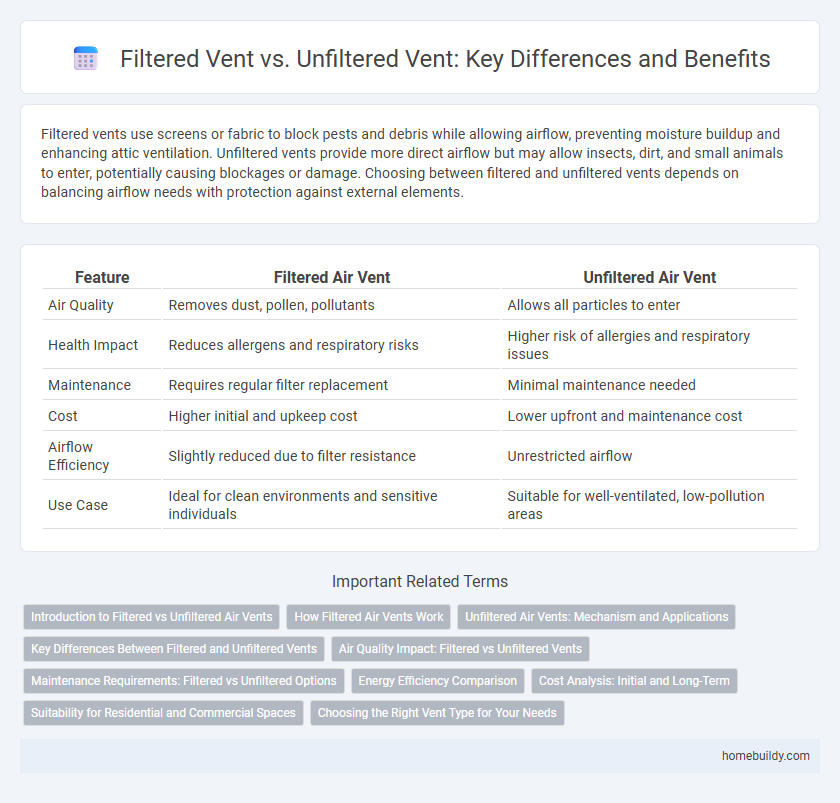Filtered vents use screens or fabric to block pests and debris while allowing airflow, preventing moisture buildup and enhancing attic ventilation. Unfiltered vents provide more direct airflow but may allow insects, dirt, and small animals to enter, potentially causing blockages or damage. Choosing between filtered and unfiltered vents depends on balancing airflow needs with protection against external elements.
Table of Comparison
| Feature | Filtered Air Vent | Unfiltered Air Vent |
|---|---|---|
| Air Quality | Removes dust, pollen, pollutants | Allows all particles to enter |
| Health Impact | Reduces allergens and respiratory risks | Higher risk of allergies and respiratory issues |
| Maintenance | Requires regular filter replacement | Minimal maintenance needed |
| Cost | Higher initial and upkeep cost | Lower upfront and maintenance cost |
| Airflow Efficiency | Slightly reduced due to filter resistance | Unrestricted airflow |
| Use Case | Ideal for clean environments and sensitive individuals | Suitable for well-ventilated, low-pollution areas |
Introduction to Filtered vs Unfiltered Air Vents
Filtered air vents incorporate specialized filtration systems that remove dust, allergens, and pollutants from the incoming air, enhancing indoor air quality and protecting HVAC components. Unfiltered air vents allow air to flow freely without barriers, which may lead to increased particulate matter entering ventilation systems and living spaces. Choosing between filtered and unfiltered vents depends on environmental conditions and the need for air purity in specific applications.
How Filtered Air Vents Work
Filtered air vents use a specialized mesh or media that traps dust, pollen, and other airborne particles, improving indoor air quality by preventing contaminants from entering ventilation systems. These vents maintain consistent airflow while reducing allergens and pollutants, making them ideal for environments requiring clean air, such as hospitals and laboratories. Unfiltered vents lack this mechanism, allowing unpurified air and airborne particles to circulate freely, potentially compromising air quality.
Unfiltered Air Vents: Mechanism and Applications
Unfiltered air vents allow direct airflow without obstruction, facilitating rapid ventilation but exposing interiors to contaminants such as dust, pollen, and moisture. These vents operate via simple openings or louvers designed to maximize air exchange efficiency in environments where filtration is not critical. Common applications include industrial settings, certain HVAC systems, and equipment enclosures where unfiltered airflow ensures temperature regulation and pressure equalization.
Key Differences Between Filtered and Unfiltered Vents
Filtered vents incorporate a mesh or filter media designed to block dust, debris, and contaminants from entering the ventilation system, enhancing indoor air quality and protecting HVAC components. Unfiltered vents lack this barrier, allowing unclean air and particles to pass freely, which may lead to increased wear and potential health risks. The presence of filtration in vents significantly impacts maintenance needs, system lifespan, and air purity levels.
Air Quality Impact: Filtered vs Unfiltered Vents
Filtered air vents significantly improve indoor air quality by trapping dust, pollen, and pollutants, reducing airborne contaminants that can trigger allergies and respiratory issues. Unfiltered vents allow unimpeded airflow but also permit pollutants and particulate matter to circulate freely, potentially degrading air quality and increasing health risks. Choosing filtered vents enhances ventilation efficiency while maintaining cleaner air environments, crucial for sensitive populations.
Maintenance Requirements: Filtered vs Unfiltered Options
Filtered air vents require periodic replacement or cleaning of filters to maintain airflow efficiency and prevent dust buildup, reducing the risk of HVAC system damage. Unfiltered vents demand less frequent maintenance but allow more contaminants, which can lead to increased dust accumulation on components and potentially higher long-term cleaning costs. Choosing filtered vents enhances indoor air quality while necessitating a regular maintenance schedule to ensure optimal performance.
Energy Efficiency Comparison
Filtered air vents improve energy efficiency by preventing dust and debris from obstructing airflow, which helps HVAC systems operate more effectively and reduces energy consumption. Unfiltered vents allow contaminants to accumulate in ducts and equipment, causing strain on heating and cooling systems and increasing energy usage. Maintaining filtered vents ensures optimal airflow and system longevity, leading to lower utility costs and enhanced energy savings.
Cost Analysis: Initial and Long-Term
Filtered air vents have a higher initial cost due to the inclusion of filtration materials and more complex construction but reduce long-term expenses by preventing dust and moisture damage to HVAC systems. Unfiltered vents offer lower upfront costs but can lead to increased maintenance, higher energy bills, and more frequent equipment replacements due to contamination buildup. Businesses and homeowners should weigh the initial investment against the potential savings from improved system longevity and efficiency when choosing between filtered and unfiltered vents.
Suitability for Residential and Commercial Spaces
Filtered air vents effectively improve indoor air quality by trapping dust, pollen, and other airborne contaminants, making them ideal for residential spaces where health and comfort are priorities. Unfiltered vents, while simpler and more cost-effective, may be better suited for commercial or industrial environments where high airflow is essential and air quality control is less critical. Selecting between filtered and unfiltered vents depends on specific ventilation needs, occupancy levels, and the desired balance between air purity and airflow efficiency.
Choosing the Right Vent Type for Your Needs
Filtered vents provide superior protection against dust, allergens, and airborne pollutants, making them ideal for environments requiring clean air quality such as homes with allergy sufferers or industrial settings. Unfiltered vents offer higher airflow efficiency and lower maintenance, suitable for areas where ventilation speed is prioritized over air purity, like garages or workshops. Selecting the appropriate vent type depends on balancing airflow requirements with the need for air filtration based on the specific environmental and health considerations of the space.
filtered vent vs unfiltered vent Infographic

 homebuildy.com
homebuildy.com